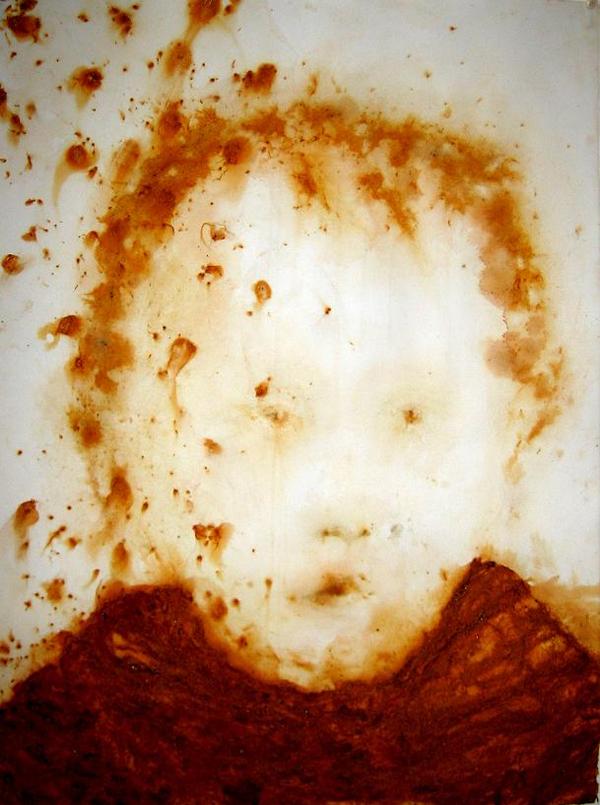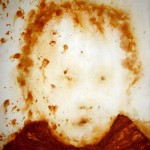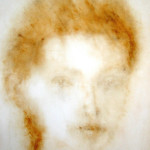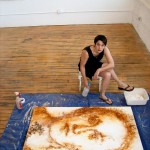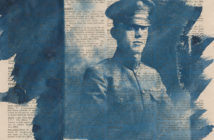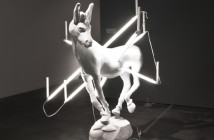While the process of oxidization of iron and the resulting rust is usually associated with the decay of an object through the breaking down of its material, Providence artist Esther Solondz instead employs this process to create images.
The method Solondz has developed is seemingly simple: after sketching out an image on cotton paper, iron filings and steel wool are applied, and salt and water are added to start the development of rust. Slowly, over several days, an image emerges; the rust-colored drawing literally growing form the paper by itself, with soft, diffused lines creating a fuzzy, muted, over-sized portrait.
This way of working is a continuation of Solodnz’s previous work in which she employed the transformative qualities of materials like soap, seeds, water, mud, and salt to address the subject of constant change. The subject as well as the process grew out of the material aspect of the work as it continued to change from one state to another.
Solondz, who is an avid gardener, likens this process to working in her yard: once the seeds are sown, she sits back, waiting for them to germinate and observes plants growing.
The process is also directly related to photography, which was Solondz’s major at RISD. Here, as in photography, a chemical process is used to create an image: instead of an image captured on film and being projected onto photographic paper to be developed, the iron filings are being activated by a salt solution to leave an image on paper. In addition to studying photography, Solondz received a master’s degree from NYU in film, a medium, like photography, often employed to bring narrative to imagery.
The pictures created in these recent rust paintings tell a story of people. Over the last two years Solondz has worked with old photographs and images she found on the Internet to assemble the portraits of anonymous persons, or ‘heads,’ currently on view at the Newport Art Museum.
The people that Solondz depicts on individual panels, approximately 2 x 3 feet large, all seem to have a neutral facial expression. No smiles, no laughter, no manifestation of emotions. But strangely, when viewed together the faces convey a somber and serious expression projecting a heavy shared burden, as if these are portraits of lost family members or holocaust victims. The rusty color of the images is easily associated with the sepia tones of old family photographs and strengthens the impression that these images are depicting deceased persons.
Each individual head makes eye contact with the viewer with a distant, detached stare and, regardless of the angle a painting is viewed from, establishes an instant connection between the observer and the individual depicted. The importance of the eyes becomes even more obvious when viewing these images displayed in a group; the juxtaposition of the faces intensifies their gaze. And while Solondz insists that these paintings of heads are not portraits, with titles like “Wini Edmunds” and “Flora Mcivor” these unknown individuals, all named after roses that were named after people, become more personalized still.
The process by which Solodnz develops these images relies on growth over time and speaks of emergence, but the image itself implies disappearance over time. The most important ingredient in the process therefore becomes time: the time it takes for an image to appear on one hand and a period of time over which people disappear. Two opposing strands of time are running through these pieces with tension captured at the intersection of those different views of time and the distinct ways that change happens over time: material like iron transforms, but does not disappear in this metamorphosis. An individual person, however, fades into memory and ceases to exist.
The title ‘There and Not There,’ too, expresses the fact that the surfacing of an image is employed to depict a person who ceases to exist but create a permanent image. And while the process addresses the surface, or materiality, the content of the image is instead about making visible what lies below the surface. The artistic achievement here is Solondz’s ability to create something that you can see and not see at the same time.
- Esther Solondz, Graham Thomas, Rust on paper on panel, 2009.
- Esther Solondz, Flora McIvor, Rust on paper on panel, 2010.
- Esther Solondz at work.
"There and Not There: Rust Portraits by Esther Solondz" is on view through June 6, 2010.
All images are courtesy of the artist and the Newport Art Museum.

